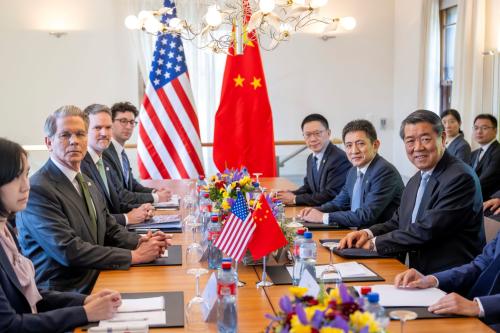Japanese Prime Minister Abe’s statement of his country’s willingness to join the Trans-Pacific Partnership (TPP) negotiations is good for the U.S., Japan and the TPP. It follows former Japanese Prime Minister Noda’s announcement at the Asia-Pacific Economic Cooperation (APEC) in 2011 of Japan’s interest in the TPP negotiations and almost two years of discussions between the Japanese government and the other TPP parties on their expectations should Japan join the trade agreement. The TPP parties currently include the U.S., Australia, Brunei, Canada, Chile, Malaysia, Mexico, New Zealand, Peru, Singapore and Vietnam.
Japan’s participation in the TPP will boost the agreement’s economic and strategic significance. The TPP aims to be the 21st century trade agreement that sets the rules for trade and investment in the Asia-Pacific region going forward. Achieving this goal will require other major economies in the Asia-Pacific region to join the agreement with the intention of the TPP ultimately becoming a Free Trade Agreement of the Asia-Pacific (FTAAP), and Japan’s participation in the TPP will give added momentum towards this goal. For one, with Japan the TPP will cover 8.6 percent of global trade and almost 40 percent of global GDP. Japan’s entry into the TPP is also likely to give further impetus to other countries joining the TPP. In particular South Korea, which already has an FTA with the U.S., should now see the TPP as a key opportunity to negotiate new market access opportunities with Japan, with which it has a $108 billion trading relationship. Other countries such as Colombia, the Philippines and Thailand are also watching the TPP negotiations careful with an eye to joining.
Japan’s participation in the TPP is also of economic significance for the U.S. Without Japan’s participation in the TPP the market access opportunities for the U.S. are limited because the U.S. has FTAs with six of the 10 TPP parties. Should the TPP lead to new market liberalization beyond what has already been promised in their current FTAs with the U.S., the already significant liberalization committed to under these FTAs means that any new market access gains for the U.S. will be minimal.
In contrast, the U.S. does not have an FTA with Japan, which is the world’s third largest economy with significant tariff and nontariff barriers in areas of key export interest for the U.S., ranging from agriculture to automobiles to financial services. As a result, an ambitious outcome in the TPP could provide the U.S. with important new markets. Its potential economic value is highlighted by the size of total bilateral trade of $220 billion in 2012 and a trade deficit of $80 billion. But this understates the size of the trading relationship as many Japanese goods and services are now inputs into final goods exported from countries such as China and South Korea. Value-added trade data more accurately captures these dimensions, and on a value-added basis the U.S. trade deficit with Japan increases by approximately 60 percent. Additionally, there is a significant bilateral investment relationship, with U.S. foreign direct investment (FDI) in Japan valued at $134 billion in 2010 and Japanese FDI in the U.S. valued at over $240 billion
Japan’s participation in the TPP is also good for Japan. It will provide new market access opportunities for Japanese exporters amongst the TPP parties. But even more significantly, the TPP should become a key driver of domestic economic reform – something the Japanese economy sorely needs. The TPP will lead to economic reform in Japan through a number of channels. For instance, the TPP will lower tariff rates on goods and liberalize Japan’s services sector, which constitutes 72 percent of Japan’s GDP. The TPP will also eliminate many nontariff barriers – behind the border regulations that act as barriers to trade. These measures will lead to greater competition which should increase the productivity of the Japanese economy, improving its competitiveness, including in its export sector and boosting GDP. Additionally, the TPP will include new ambitious market access for investment, rules on intellectual property, competition, telecommunications and regulatory coherence, to name a few. In fact, the TPP is better understood as a comprehensive economic integration agreement that will touch most areas of economic life.
Prime Minster Abe’s decision to commit Japan to joining the TPP should also be understood as a necessary compliment to his efforts to stimulate the Japanese economy with monetary easing and the related depreciation of the Yen. These efforts alone, without the type of economic reform the TPP will lead to, are unlikely to produce long-term improvements in Japan’s growth prospects.
A further consequence for the TPP of Japan’s participation will be a delay in finalizing the agreement. Efforts to conclude the TPP this year were always ambitious given the range of difficult issues still on the table, such as on intellectual property and state-owned enterprises. Following Japan’s announcement of its intention to join the TPP, the Obama administration will now follow a 90 day consultation period with Congress, which means that the September round of TPP negotiations will be the first opportunity for Japan’s formal participation. Irrespective of whether Japan is prepared to simply sign on to progress-to-date in the TPP, the needed new market access negotiations with Japan, combined with the existing challenges outlined above, makes completing the TPP by the end of 2014 a more realistic end date.
The Brookings Institution is committed to quality, independence, and impact.
We are supported by a diverse array of funders. In line with our values and policies, each Brookings publication represents the sole views of its author(s).



Commentary
Japan to Join the Trans-Pacific Partnership – Finally!
March 18, 2013